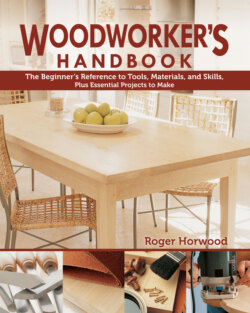Читать книгу Woodworker's Handbook - Roger Horwood - Страница 11
На сайте Литреса книга снята с продажи.
“Man-Made” Woods
ОглавлениеThere are a number of reasons why it is necessary to manufacture “manmade” woods, and among these is the fact that natural wood is becoming more and more scarce and increasingly expensive. Another factor is that large, natural-wood boards tend to warp, whereas “man-made” boards are much more stable. Built-in kitchen and bedroom units, in particular, would be very difficult and prohibitively expensive to produce in natural wood.
MDF
Medium-Density Fiberboard (MDF)
This board is manufactured by reducing wood to a very fine fiber, mixing it with resin, and then compressing it under pressure to form sheets. Standard sizes and thicknesses vary from country to country, with ½ in. (12 mm) or the closest available thickness being the most suitable for general furniture-making. Your local hardware store or lumberyard (woodyard) should be able to supply sheets of almost any size you require. This wood has a very smooth finish, which can be hand- or spray-painted, and is also very versatile as it can be routed and shaped relatively easily. In blocks thick enough, it also turns remarkably well!
Plywood
Plywood
In woodworking, there is often a need for relatively thin boards that have a high strength-to-weight ratio, for example panels in doors or cabinets, and drawer bottoms. This is where plywood comes into its own. It is made by laminating thin sheets of wood so that the grain of each sheet is at right angles to the one adjacent to it.
Plywood is usually produced in sheets of 8 ft. (2.44 m) by 4 ft. (1.22 m) and in a variety of thicknesses, ranging from a very thin three-ply (about ⅛ in. [3 mm] thick) to multi-ply (about 1 in. [25 mm] thick). Your local lumberyard (woodyard) should have any dimensions you require.
Although the surface is not as smooth as MDF, plywood has a natural-wood appearance and is far stronger than MDF.
Blockboard
Blockboard (Copine, Pre-glued Panels)
While long, wide boards of natural wood can be unstable, there is still a demand for them. To meet this demand the timber industry has come up with the solution of gluing together strips of pine or oak, which are about 1 ⅜ in. (35 mm) wide and ¼–⅞ in. (6–22 mm) thick, to form boards up to 28 in. (700 mm) wide. Blockboard, while being very strong and stable, retains the appearance of natural wood. Boards are manufactured in a variety of widths and lengths, up to about 28 in. (700 mm) wide by up to 13 ft. (4 m) long and usually in a standard thickness of ⅞ in. (22 mm).
Particleboard (Chipboard)
Particleboard (chipboard)
Similar in some ways to MDF, particleboard is made by mixing wood chips with resin and then compressing it under pressure to form sheets of similar size and thickness to MDF. This is not a satisfactory wood for furniture-making and household projects as it does not finish very well, splits easily on the end grain and seems to be especially hard on saw blades. It can, however, be used where the surface will not be visible, for example in the construction of upholstered furniture.
Veneered particleboard (chipboard)
Veneered Particleboard (Chipboard)
Veneered particleboard looks and finishes better than plain particleboard. Mass-produced furniture is often made from this material, but because of its unattractive end grain, it should be avoided for furniture-making and household use.
